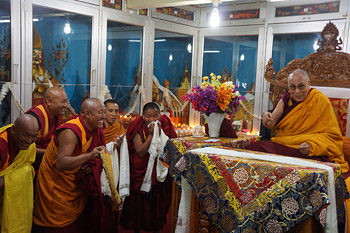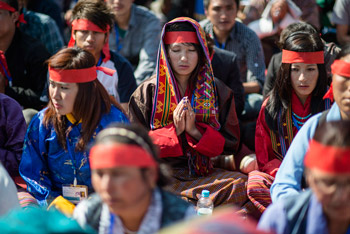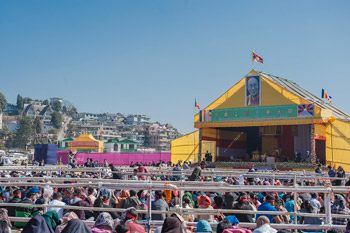Empowerment and Teaching at Shillong Polo Ground
05/02/2014 14:41 (GMT+7) Font size:  
Shillong, Meghalaya, India - 4 February 2014 - Nestling in the village of Lumparing in the hills above Shillong is the small Tibetan monastery of Ganden Chöling. It was originally founded in 1957 by someone from Bhutan, but has since come under the administration of the Gelug Magon, a shared body comprising Sera, Drepung and Ganden monasteries. Drepung Loseling is the current administrator. With a dozen resident monks, the monastery is the principal place of worship for many of the 1000 Tibetans who live in Shillong. His Holiness the Dalai Lama paid the monastery a short visit this morning. Tibetans and other curious local residents lined the road as he drove by. Tibetan children offered a traditional welcome when he arrived. 
| His Holiness the Dalai Lama shares a moment of laughter with the monks at Ganden Choling in Lamparing, Meghalaya, India on February 4, 2014. Photo/Jeremy Russell/OHHDL
|
Inside the small temple, His Holiness first paid his respects in front of the image of the Buddha. He then recited auspicious prayers of consecration, casting grains into the air by way of offerings as he did so. He examined the various statues enshrined around the walls and took his seat on the throne. Noting that volumes of the Kangyur and Tengyur had been placed in alcoves at the top of the walls, just below the ceiling he gave firm advice that it would be better if they were both more visible and more accessible on shelves lower down. Tea and ceremonial rice were served to the visitors accompanying His Holiness, the monks and supportive local Indian friends.
His Holiness told those assembled that he frequently advises Tibetans and others of the need to be 21st century Buddhists. He clarified that he means that they should not be content with merely reciting mantras and prayers. They should understand what Buddhism means, which requires study and learning. He strongly advised that the monastery become a centre of learning, a place where Buddhists and others can study and discuss what they learn and exchange views. This is the way to emulate the Nalanda tradition.
When His Holiness arrived at the Shillong Polo Ground, many of the eventual 5000 people attending his teaching had already found places. While the audience recited Om mani padme hung and a group of monks engaged in energetic debate, he began the preparatory rituals for an Avalokiteshvara empowerment. He explained that as an introduction to Buddhism he would read the ‘37 Practices of a Bodhisattva’. Impromptu arrangements were made for His Holiness’s words to be translated into the Mönpa language, Bhutanese and English.

| His Holiness the Dalai Lama acknowledging the crowd of over 5000 gathered to attend his teachings at the Polo Ground in Shillong, Meghalaya, India on February 4, 2014. Photo/Tenzin Choejor/OHHDL
|
“In this world are many religions,” His Holiness began, “of which Buddhism is one. They all convey a message of love and compassion, forgiveness, contentment and self-discipline. This is supported by a variety of philosophical views. For some, God the creator embodies infinite love and compassion. For others, like Buddhists, Jains and a branch of the Samkhyas there is no creator but the law of causality. Buddhism in particular teaches about interdependence. If you harm others suffering ensues; being helpful to them results in happiness. The end result is also the cultivation of love and compassion. Because of what they have in common, we should regard all religious traditions with respect.
“I often repeat what I heard a Sufi say, that religious traditions with philosophical views generally answer three questions - What is the self? Does it have a beginning and does it come to an end? Buddhists say the self is merely designated upon the mental and physical aggregates. There is no self apart from our body and mind. Other traditions assert a self separate from them. To the second question about a beginning, believers in a creator god say he created the self, so that’s the beginning. Others say he created it and it goes on from life to life. The Buddhist position is that the self is designated on the basis of the body and mind, but that ultimately as neither matter nor consciousness have a beginning, the self doesn’t either.
“Believers in god say the self goes on to heaven or hell, and I’ve asked but not received a clear answer to what happens after that. Because god is described in terms of infinite love, god’s creations have a spark of that love. This is not unlike the explanation of Buddha nature. As to the end of self, Hindus suggest it dissolves back into the greater atman, and Jains and Samkhyas claim self exists and goes on to liberation. In Buddhism we say that negative emotions can be eliminated from our minds just as darkness is eliminated by the presence of light. Ignorance and the disturbing emotions can be overcome and removed when we apply the counter factors, which are understanding and awareness.”

| Members of the audience attending the Avalokiteshvara Empowerment given by His Holiness the Dalai Lama at the Polo Ground in Shillong, Meghalaya, India on February 4, 2014. Photo/Tenzin Choejor/OHHDL
|
His Holiness recalled that the Buddha first taught the Four Noble Truths to the first five human disciples in Varanasi. He initially advised them how to wear their robes, which was an aspect of monastic discipline. Sutras record that he also taught about concentration and wisdom. For followers of both the Pali and Sanskrit traditions, the monastic vows are basically the same. The explanation of concentration is also the same. But the way he taught about wisdom on Vulture’s Peak, the Perfection of Wisdom teachings is unique to the Sanskrit tradition. These teachings were conveyed to China and from there reached Tibet, but eventually the Tibetan Emperor, Trisong Deutsan invited Shantarakshita from India, which marks the real beginning of the transmission of Buddhism in Tibet.
His Holiness proceeded to give the empowerment of Thousand Armed Avalokiteshvara, in the course of which he led his listeners through the generation of the awakening mind of bodhichitta and the Bodhisattva vows.
After lunch, he again referred to Shantarakshita, who was a great scholar from Nalanda University. His disciple Kamalashila was similarly a scholar, philosopher and logician. Between them they established Tibetan Buddhism as a tradition based on study, scholarship and practice. Later, great Tibetan scholars like Rongzom Chojey, and the Sakya master, Buton Rinpoche emerged. In addition there were the three famed aspects of Manjushri, Sakya Pandita, Longchen Rabjampa and Je Tsongkhapa.
“The author of this text, Thogme Sangpo is a part of this tradition and was also renowned as a Bodhisattva. I received transmission and explanation of this text from Khunu Lama Rinpoche. The author opens his text by paying homage to Lokeshvara.”
During his reading His Holiness pointed out that ignorance is to adopt a mistaken view. It gives rise to suffering. Rather than existing independently, things come about in dependence on other factors. He was clear that prayer alone will not overcome this ignorance. We tend to see the impure as pure, the miserable as happy. Because we think we will live forever we cling to things, letting go of this life is a practice of Bodhisattvas.

| A view of the Polo Ground with over 5000 people attending His Holiness the Dalai Lama's teachings in Shillong, Meghalaya, India on February 4, 2014. Photo/Tenzin Choejor/OHHDL
|
A section of the text refers to the qualities of a spiritual master. The Vinaya and Sutras have different accounts of these, but they may be summarized by his or her being learned, compassionate, humble and disciplined. His Holiness advised that before making a commitment to a spiritual master it is crucial to thoroughly examine him or her first.
“The Buddha explained the Four Noble Truths, suffering, its cause, cessation and the path. Suffering he described on three levels, the obvious suffering of ordinary pain, the changeable suffering of experiences we enjoy, and the conditioned suffering that pervades existence. We have to examine whether suffering can be overcome or not. We discover that by applying counter forces, suffering can be surmounted. While other traditions have their various objects of solace and refuge, Buddhists take refuge in the Three Jewels, the Buddha, Dharma and Sangha.
“The important thing is to study the Dharma. In the Kangyur and Tengyur we have 300 volumes of scripture that are not meant to be simple objects of respect and offering, but are to be read. I wrote about these points in my praise to the 17 Masters of Nalanda:
By understanding the meaning of the two truths, the way things exist,
We ascertain through the four truths how we arrive in and how we leave the cycle of existence.
Engendered by valid cognition our faith in the three refuges will be firm.
May we be blessed to establish the root of the path to liberation.” http://www.dalailama.com/
|